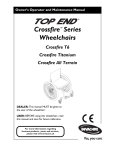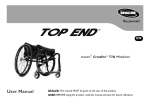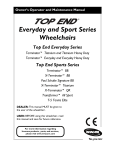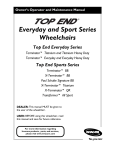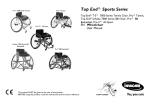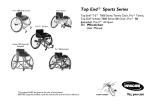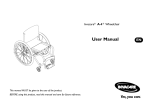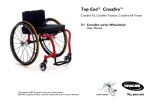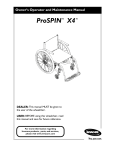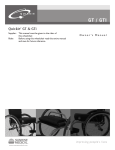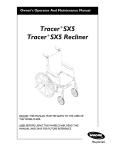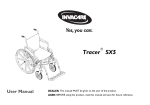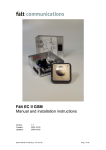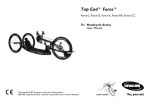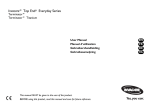Download Crossfire User Manual
Transcript
Owner’s Operator and Maintenance Manual ® Crossfire™Series Wheelchairs Crossfire T6 Crossfire Titanium DEALER: This manual MUST be given to the user of the wheelchair. USER: BEFORE using this wheelchair, read this manual and save for future reference. For more information regarding Invacare products, parts, and services, please visit www.invacare.com WARNING DO NOT OPERATE THIS EQUIPMENT WITHOUT FIRST READING AND UNDERSTANDING THIS MANUAL. IF YOU ARE UNABLE TO UNDERSTAND THE WARNINGS, CAUTIONS AND INSTRUCTIONS, CONTACT YOUR INVACARE DEALER OR INVACARE CUSTOMER SUPPORT AT (800) 532-8677 BEFORE ATTEMPTING TO USE THIS EQUIPMENT - OTHERWISE INJURY AND/OR EQUIPMENT DAMAGE MAY OCCUR. NOTE: Updated versions of this manual are available on www.invacare.com. Crossfire™Series Wheelchairs 2 Part No 1134872 TABLE OF CONTENTS TABLE OF CONTENTS REGISTER YOUR PRODUCT ............................................................... 6 SPECIAL NOTES ................................................................................ 9 TYPICAL PRODUCT PARAMETERS .................................................. 11 SECTION 1—GENERAL GUIDELINES ................................................. 13 Stability Warning.......................................................................................................................................13 Operating Information.............................................................................................................................14 Tire Pressure and Information ..............................................................................................................15 Weight Training ........................................................................................................................................15 Weight Limitation.....................................................................................................................................15 SECTION 2—SAFE HANDLING ......................................................... 16 Stability and Balance.................................................................................................................................16 Coping with Everyday Obstacles......................................................................................................17 A Note to Wheelchair Assistants....................................................................................................18 Reaching, Leaning and Bending - Forward......................................................................................18 Reaching, Leaning - Backwards .........................................................................................................18 Tipping.........................................................................................................................................................19 Tipping - Curbs .........................................................................................................................................19 Stairways.....................................................................................................................................................20 Transferring To and From Other Seats ..............................................................................................21 SECTION 3—SAFETY INSPECTION ................................................... 22 Safety Inspection Checklist.....................................................................................................................22 Inspect Initially ......................................................................................................................................22 Inspect/Adjust Weekly........................................................................................................................23 Inspect/Adjust Monthly.......................................................................................................................23 Inspect/Adjust Periodically.................................................................................................................24 Troubleshooting........................................................................................................................................24 Maintenance ...............................................................................................................................................25 Maintenance Safety Precautions .......................................................................................................25 Suggested Maintenance Procedures ................................................................................................25 SECTION 4—FOOTREST ................................................................... 27 Adjusting/Replacing Standard Footrest................................................................................................27 Replacing the Footrest........................................................................................................................27 Adjusting the Footrest ........................................................................................................................27 Installing/Adjusting Optional Clamp on Raised Footrest ................................................................28 Installing..................................................................................................................................................28 Adjusting ................................................................................................................................................28 Replacing/Adjusting Optional Adjustable Angle Footrest ...............................................................28 Part No 1134872 3 Crossfire™Series Wheelchairs TABLE OF CONTENTS TABLE OF CONTENTS Replacing the Footrest........................................................................................................................28 Adjusting Footplate Angle..................................................................................................................29 Adjusting Footplate Depth.................................................................................................................29 SECTION 5—ARMS ......................................................................... 30 Installing the Swingaway Padded Armrest Socket Assembly..........................................................30 Adjusting Swingaway Padded Armrest Height...................................................................................31 SECTION 6—BACK ......................................................................... 32 Unfolding/Folding the Back.....................................................................................................................32 Back Angle Adjustment ...........................................................................................................................32 Adjustable Tension Back Upholstery ...................................................................................................34 The Adjustable Tension Straps .........................................................................................................34 The Back Upholstery Cover..............................................................................................................34 Replacing Adjustable Tension Back Upholstery............................................................................34 Removing/Installing Foldover Back Upholstery .................................................................................36 Removing Foldover Back Upholstery..............................................................................................36 Installing Foldover Back Upholstery ................................................................................................36 Back Height Adjustment (Adjustable Backs Only)............................................................................37 SECTION 7—SEAT ........................................................................... 38 Replacing Adjustable Tension Seat Upholstery .................................................................................38 SECTION 8—WHEELS ....................................................................... 40 Removing/Installing Rear Wheels .........................................................................................................40 Adjusting Quick-Release Axles..............................................................................................................41 Replacing Quad-Release Axles ..............................................................................................................41 Adjusting Quad-Release Handles..........................................................................................................42 In and/or Out ........................................................................................................................................42 Removing Play from Rear Wheels ...................................................................................................42 Handrim Replacement.............................................................................................................................43 Repairing/Replacing Rear Wheel, Tire/Tube......................................................................................44 Adjusting Wheelbase Length (Adjusting Center of Gravity)..........................................................44 Repositioning the Camber Tube Mounting Brackets ..................................................................46 Repositioning the Camber Tube Mounting Bracket Socket Screws ........................................46 Reversing the Camber Tube Mounting Bracket Direction ........................................................47 Adjusting Wheelbase Width ..................................................................................................................48 Removing/Installing/ the Camber Tube ...............................................................................................49 Removing the Camber Tube .............................................................................................................49 Installing the Camber Tube ...............................................................................................................49 Adjusting the Camber Tube...................................................................................................................50 Crossfire™Series Wheelchairs 4 Part No 1134872 TABLE OF CONTENTS TABLE OF CONTENTS Determining Toe In/Toe Out ................................................................................................................51 Adjusting Fork Tension ...........................................................................................................................52 Removing/Installing/Repositioning the Caster Assemblies..............................................................53 Standard Forks......................................................................................................................................53 Suspension Forks..................................................................................................................................53 Removing/Installing the Fork Assembly...............................................................................................54 Removing Fork Assembly...................................................................................................................54 Installing Fork Assembly .....................................................................................................................55 Removing/Installing the Elastomers (Suspension Forks Only)................................................................................................................................56 Removing the Elastomer ....................................................................................................................56 Installing the Elastomer.......................................................................................................................56 SECTION 9—WHEEL LOCKS ............................................................. 57 Replacing/Adjusting the Wheel Locks .................................................................................................57 Replacing the Wheel Lock .................................................................................................................57 Adjusting the Wheel Lock .................................................................................................................57 Changing Wheel Lock Handle Position...............................................................................................58 Converting Wheel Lock From Push-to-Lock to Pull-to-Lock or Pull-to-Lock to Push-to-Lock ..........................................................................................59 Converting From Push-to-Lock to Pull-to-Lock...........................................................................59 Converting From Pull-to-Lock to Push-to-Lock...........................................................................59 SECTION 10—ANTI-TIPPER ............................................................. 60 Adjusting/Replacing Anti-tipper.............................................................................................................60 Adjusting Anti-tipper...........................................................................................................................60 Replacing Anti-tipper...........................................................................................................................61 LIMITED WARRANTY ..................................................................... 63 Part No 1134872 5 Crossfire™Series Wheelchairs REGISTER YOUR PRODUCT REGISTER YOUR PRODUCT The benefits of registering: 1. 2. 3. 4. 5. Safeguard your investment. Ensure long term maintenance and servicing of your purchase. Receive updates with product information, maintenance tips, and industry news. Invacare can contact you or your provider, if servicing is needed on your product. It will enable Invacare to improve product designs based on your input and needs. Register ONLINE at www.invacare.com - or Complete and mail the form on the next page Any registration information you submit will be used by Invacare Corporation only, and protected as required by applicable laws and regulations. Crossfire™Series Wheelchairs 6 Part No 1134872 PRODUCT REGISTRATION FORM Register ONLINE at www.invacare.com - or Complete and mail this form Name _______________________________________________________________ Address _____________________________________________________________ City ___________________ State/Province __________ Zip/Postal Code ________ Email ___________________________________ Phone No. _________________ Fold here Invacare Model No. ______________________ Serial No. __________________ Purchased From _________________________ Date of Purchase: ___________ Cut Along Line 1. Method of purchase: (check all that apply) ❏ Medicare ❏ Insurance ❏ Medicaid ❏ Other __________________________ 2. This product was purchased for use by: (check one) ❏ Self ❏ Parent ❏ Spouse ❏ Other 3. Product was purchased for use at: ❏ Home ❏ Facility ❏ Other 4. I purchased an Invacare product because: ❏ Price ❏ Features (list features) _________________________________________ 5. Who referred you to Invacare products? (check all that apply) ❏ Doctor ❏ Therapist ❏ Friend ❏ Relative ❏ Dealer/Provider ❏ Other_________ ❏ Advertisement (circle one): TV, Radio, Magazine, Newspaper ❏ No Referral_____ 6. What additional features, if any, would you like to see on this product? __________________________________________________________________________ Fold 7. Would you like information sent to you about Invacare products that may be available for a here particular medical condition? ❏ Yes ❏ No If yes, please list any condition(s) here and we will send you information by email and/or mail about any available Invacare products that may help treat, care for or manage such condition(s): __________________________________________________________________________ 8. Would you like to receive updated information via email or regular mail about the Invacare home medical products sold by Invacare's dealers? ❏ Yes ❏ No 9. What would you like to see on the Invacare website? __________________________________________________________________________ 10. Would you like to be part of future online surveys for Invacare products? ❏ Yes ❏ No 11. User's Year of birth: ______________________________________________________ If at any time you wish not to receive future mailings from us, please contact us at Invacare Corporation, CRM Department, 39400 Taylor Parkway, Elyria, OH 44035, or fax to 877-619-7996 and we will remove you from our mailing list. To find more information about our products, visit www.invacare.com. Part No 1134872 7 Crossfire™Series Wheelchairs Cut Along Line Fold here Fold here Invacare Product Registration Form Please Seal with Tape Before Mailing Crossfire™Series Wheelchairs 8 Part No 1134872 SPECIAL NOTES SPECIAL NOTES Signal words are used in this manual and apply to hazards or unsafe practices which could result in personal injury or property damage. Refer to the table below for definitions of the signal words. SIGNAL WORD MEANING DANGER Danger indicates an imminently hazardous situation which, if not avoided, will result in death or serious injury. WARNING Warning indicates a potentially hazardous situation which, if not avoided, could result in death or serious injury. CAUTION Caution indicates a potentially hazardous situation which, if not avoided, may result in property damage. NOTICE THE INFORMATION CONTAINED IN THIS DOCUMENT IS SUBJECT TO CHANGE WITHOUT NOTICE. As a manufacturer of wheelchairs, Invacare endeavors to supply a wide variety of wheelchairs to meet many needs of the end user. However, final selection of the type of wheelchair to be used by an individual rests solely with the user and his/her healthcare professional capable of making such a selection. WHEELCHAIR TIE-DOWN RESTRAINTS AND SEAT POSITIONING STRAPS Invacare recommends that wheelchair users not be transported in vehicles of any kind while in wheelchairs. As of this date, the Department of Transportation has not approved any tie-down systems for transportation of a user while in a wheelchair, in a moving vehicle of any type. It is Invacare’s position that users of wheelchairs should be transferred into appropriate seating in vehicles for transportation and use be made of the restraints made available by the auto industry. Invacare cannot and does not recommend any wheelchair transportation systems. WARNING Invacare products are specifically designed and manufactured for use in conjunction with Invacare accessories. Accessories designed by other manufacturers have not been tested by Invacare and are not recommended for use with Invacare products. SEAT POSITIONING STRAP ALWAYS wear your seat positioning strap. Inasmuch as the seat positioning strap is an option on this wheelchair (you may order with or without the seat positioning strap), Invacare Top End strongly recommends ordering the seat positioning strap as an additional safeguard for the wheelchair user. The seat positioning strap is a positioning belt only. It is not designed for use as a safety device withstanding high stress loads such as auto or aircraft safety belts. If signs of wear appear, seat positioning strap MUST be replaced IMMEDIATELY. Part No 1134872 9 Crossfire™Series Wheelchairs SPECIAL NOTES WARNING With regard to restraints - seat/chest positioning straps - it is the obligation of the DME dealer, therapists and other healthcare professionals to determine if a seat/chest positioning strap is required to ensure the safe operation of this equipment by the user. SERIOUS INJURY CAN OCCUR IN THE EVENT OF A FALL FROM A WHEELCHAIR. Crossfire™Series Wheelchairs 10 Part No 1134872 TYPICAL PRODUCT PARAMETERS TYPICAL PRODUCT PARAMETERS NOTE: All specifications are approximate. FRAME: FRONT FRAME: CROSSFIRE T6 CROSSFIRE TITANIUM 6061T6 Aluminum Grade 9 Titanium Tapered front end (Standard), V-Style (Optional) FRONT FRAME ANGLE: FOOTREST: SEAT HEIGHT FRONT: REAR: 70°, 75°, 80°, 85° or 90° Tubular footrest in same material as frame (Standard), Adjustable Angle NCO, Plastic or Carbon Fiber Cover (Optional) 16 to 21 inches (Fixed) 14 to 20 Inches (Fixed), Ergo Level Seat (Optional) ARMS (OPTIONAL): SIDE GUARDS (OPTIONAL) FOLDING BACK: FIXED BACK: Swing-away Style Removable, Folding, Removable with Fender Fixed Aluminum, Fixed Carbon Fiber SEAT WIDTH: 12 to 18 inches (Standard), 19 to 20 inches (Optional), Tapered Seat Width (Optional) SEAT DEPTH: 14 to 18 inches (Standard), 19 to 20 inches (Optional) BACK STYLE: Folding (Standard), Fixed (Optional) BACK HEIGHT ADJUSTABLE: FIXED: BACK ANGLE FOLDING: FIXED: 8 to 11, 10 to 14, 12 to 16, 14 to 18, or 16 to 20 inches Not Available 8 to 11, 10 to 14, 12 to 16, 14 to 18, or 16 to 20 inches 8 to 16 inches -15°, -10°, -5°, 0° and 5° Not Available -15°, -10°, -5°, 0° and 5° 0°, 3°, 6°, and 9° BACK UPHOLSTERY: U850 Black - Adjustable Tension by Straps SEAT UPHOLSTERY: U850 Black - Adjustable Tension by Straps AXLE POSITIONS/CENTER OF GRAVITY: Adjustable to 4¼ inches in two positions: Amputee Position: -2¼ to 2 inches Active Position: 1¼ to 5½ inches REAR WHEEL AXLE: Quick Release (Standard), Quad-Release or Titanium (Optional) REAR WHEEL CAMBER CAMBER TUBE: REAR WHEELS REAR WHEEL TYPE: REAR WHEEL SIZE: HANDRIMS: 0°, 3°, 6°, or 9° High Performance with Primo Tires (Standard), Spinergy® Spox, knobby, KIK® and Kenda Tires (Optional) 22, 24 or 25-inch (Standard), 26-inch (Optional) Aluminum Anodized (Standard) Titanium, Coated, Natural Fit® (Optional) WHEEL LOCKS: Push to Lock (Standard) or Scissor lock (Optional) FRONT FORKS: Non-Suspension (Standard), Suspension (Optional) Part No 1134872 11 Crossfire™Series Wheelchairs TYPICAL PRODUCT PARAMETERS CROSSFIRE T6 CASTERS CASTER SIZE: CASTER TYPE: 3, 4 or 5-inch Semi-pneumatic (Standard), Soft Roll or Lighted (Optional) ANTI-TIPPERS: WEIGHT: CROSSFIRE TITANIUM Optional 19.5 lbs 18.5 lbs SHIPPING WEIGHT: 30 lbs WEIGHT LIMITATION: 250 lbs NOTE: 16 x 16-inch seat, rear wheels and minimal options are included in the weight. Crossfire™Series Wheelchairs 12 Part No 1134872 SECTION 1—GENERAL GUIDELINES SECTION 1—GENERAL GUIDELINES WARNING SECTION 1 - GENERAL GUIDELINES contains important information for the safe operation and use of this product. DO NOT use this product or any available optional equipment without first completely reading and understanding these instructions and any additional instructional material such as Owner’s Manuals, Service Manuals or Instruction Sheets supplied with this product or optional equipment. If you are unable to understand the Warnings, Cautions or Instructions, contact a healthcare professional, dealer or technical personnel before attempting to use this equipment - otherwise, injury or damage may occur. Stability Warning FOOTREST POSITION ● ● CAMBER TUBE ✓ BACK ANGLE BACK UPHOLSTERY ✓ USER CONDITION ✓ USER CONDITION BACK UPHOLSTERY BACK ANGLE CAMBER TUBE FOOTREST POSITION The position of the footrest, camber tube, back angle, the tautness of the back upholstery as well as the userʹs condition are directly related to the wheelchairs stability. Any change to one or any combination of the five may cause the wheelchair to decrease in stability. Use EXTREME caution when using a new seating position. The addition of anti-tippers may be required. ✓ ✓ ✓ ✓ ● ✓ ✓ ✓ ● ✓ ✓ ✓ ● NOTE: When changes to the left hand column occur, follow across the chart and refer to the ✓ procedure to maintain the proper stability, safety and handling of the racing chair. Part No 1134872 13 Crossfire™Series Wheelchairs SECTION 1—GENERAL GUIDELINES Operating Information To determine and establish your particular safety limits, practice bending, reaching and transferring activities in several combinations in the presence of a qualified healthcare professional before attempting active use of the wheelchair. DO NOT attempt to reach objects if you have to move forward in the seat. DO NOT attempt to reach objects if you have to pick them up from the floor by reaching down between your knees. DO NOT lean over the top of the back upholstery to reach objects from behind as this may cause the wheelchair to tip over. DO NOT shift your weight or sitting position toward the direction you are reaching as the wheelchair may tip over. DO NOT tip the wheelchair without assistance. DO NOT attempt to stop a moving wheelchair with wheel locks. Wheel locks are not brakes. NEVER leave an unoccupied wheelchair on an incline. DO NOT use an escalator to move a wheelchair between floors. Serious bodily injury may occur. Before attempting to transfer in or out of the wheelchair, every precaution should be taken to reduce the gap distance. Turn both casters parallel to the object you are transferring onto. Also be certain the wheel locks are engaged to prevent the wheels from moving. DO NOT operate on roads, streets or highways. DO NOT climb, go up or down ramps or traverse slopes greater than 9°. DO NOT attempt to move up or down an incline with a water, ice or oil film. DO NOT attempt to ride over curbs or obstacles. Doing so may cause your wheelchair to turn over and cause bodily harm or damage to the wheelchair. Invacare products are specifically designed and manufactured for use in conjunction with Invacare accessories. Accessories designed by other manufacturers have not been tested by Invacare and are not recommended for use with Invacare products. DO NOT attempt to lift the wheelchair by any removable (detachable) parts. Lifting by means of any removable (detachable) parts of a wheelchair may result in injury to the user or damage to the wheelchair. DO NOT stand on the frame of the wheelchair. Check all Allen screws that secure the footrest/raised footrest system to the wheelchair frame before using the wheelchair, especially if engaging in any contact sport. Crossfire™Series Wheelchairs 14 Part No 1134872 SECTION 1—GENERAL GUIDELINES Anti-tippers MUST be used at all times. When outdoors on wet, soft ground or on gravel surfaces, anti-tippers may not provide the same level of protection against tip over. Extra caution MUST be observed when traversing such surfaces. Inasmuch as the anti-tippers are an option on this wheelchair (you may order with or without the anti-tippers), Invacare strongly recommends ordering the anti-tippers as an additional safeguard for the wheelchair user. Unless otherwise noted, all service and adjustments should be performed while the wheelchair is unoccupied. ALWAYS wear your seat positioning strap. Inasmuch as the seat positioning strap is an option on this wheelchair (you may order with or without the seat positioning strap), Invacare Top End strongly recommends ordering the seat positioning strap as an additional safeguard for the wheelchair user. The seat positioning strap is a positioning belt only. It is not designed for use as a safety device withstanding high stress loads such as auto or aircraft safety belts. If signs of wear appear, seat positioning strap MUST be replaced IMMEDIATELY. ALWAYS use the handrims for self-propulsion. Inasmuch as the handrims are an option on this wheelchair (you may order with or without the handrims), Invacare strongly recommends ordering the handrims as an additional safeguard for the wheelchair user. DO NOT use the footplate as a platform when getting in or out of the wheelchair. Tire Pressure and Information DO NOT use your wheelchair unless it has the proper tire pressure (p.s.i.). DO NOT overinflate the tires. Failure to follow these suggestions may cause the tire to explode and cause bodily harm. The recommended tire pressure is on the sidewall of the tire. Replacement of the tire or tube MUST be performed by a qualified technician. Weight Training Invacare DOES NOT recommend the use of its wheelchairs as a weight training apparatus. Invacare wheelchairs have not been designed or tested as a seat for any kind of weight training. If occupant uses said wheelchair as a weight training apparatus, Invacare shall not be liable for bodily injury and the warranty is void. Weight Limitation Invacareʹs Top End Crossfire T6 and Crossfire Titanium wheelchairs have a weight limitation of 250 lbs. Part No 1134872 15 Crossfire™Series Wheelchairs SECTION 2—SAFE HANDLING SECTION 2—SAFE HANDLING “Safety and Handling” of the wheelchair requires the close attention of the wheelchair user as well as the assistant. This manual points out the most common procedures and techniques involved in the safe operation and maintenance of the wheelchair. It is important to practice and master these safe techniques until you are comfortable in maneuvering around the frequently encountered architectural barriers. Use this information only as a “basic” guide. The techniques that are discussed on the following pages have been used successfully by many. Individual wheelchair users often develop skills to deal with daily living activities that may differ from those described in this manual. Invacare recognizes and encourages each individual to try what works best for him/her in overcoming architectural obstacles that they may encounter, however, ALL WARNINGS and CAUTIONS given in this manual MUST be followed. Techniques in this manual are a starting point for the new wheelchair user and assistant with “safety” as the most important consideration for all. Stability and Balance WARNING ALWAYS wear your seat positioning strap. Inasmuch as the seat positioning strap is an option on this wheelchair (you may order with or without the seat positioning strap), Invacare Top End strongly recommends ordering the seat positioning strap as an additional safeguard for the wheelchair user. The seat positioning strap is a positioning belt only. It is not designed for use as a safety device withstanding high stress loads such as auto or aircraft safety belts. If signs of wear appear, seat positioning strap MUST be replaced IMMEDIATELY. Anti-tippers MUST be attached at all times. Inasmuch as the anti-tippers are an option on this wheelchair (you may order with or without the anti-tippers), Invacare strongly recommends ordering the anti-tippers as an additional safeguard for the wheelchair user. To assure stability and proper operation of your wheelchair, you must at all times maintain proper balance. Your wheelchair has been designed to remain upright and stable during normal daily activities as long as you do not move beyond the center of gravity. Virtually all activities which involve movement in the wheelchair have an effect on the center of gravity. Invacare recommends using seat positioning straps for additional safety while involved in activities that shift your weight. DO NOT lean forward out of the wheelchair any further than stability will allow. Make sure casters are pointing in the forward position whenever you lean forward. This can be achieved by advancing the wheelchair and then reversing it in a straight line. Crossfire™Series Wheelchairs 16 Part No 1134872 SECTION 2—SAFE HANDLING WARNING DO NOT attempt to reach objects if you have to move forward in the seat or pick them up from the floor by reaching down between your knees. The position of the footrest, camber tube, back angle, the tautness of the back upholstery as well as the user's condition are directly related to the wheelchair's stability. Any change to one or any combination of the five may cause the wheelchair to decrease in stability. Use EXTREME caution when using a new seating position. The addition of anti-tippers may be required. NOTE: For this procedure, refer to FIGURE 2.1. Many activities require the wheelchair owner to reach, bend and transfer in and out of the wheelchair. These movements will cause a change to the normal balance, the center of gravity, and the weight distribution of the wheelchair. To determine and establish your particular safety limits, practice bending, reaching and transferring activities in several combinations in the presence of a qualified health-care professional before attempting active use of wheelchair. Proper positioning is essential for your safety. When reaching, leaning, bending forward, it is important to use the front casters as a tool to maintain stability and balance. • Lengthening the wheelbase will increase the stability and maintain standard maneuverability of wheelchair. • Shortening the wheelbase will decrease the stability, increase the maneuverability and distribute additional weight onto the rear wheels. Center of Gravity Unoccupied Lengthening the Wheelbase Rear of Wheelchair Shortening the Wheelbase Occupied FIGURE 2.1 Stability and Balance Coping with Everyday Obstacles Coping with the irritation of everyday obstacles can be alleviated somewhat by learning how to manage your wheelchair. Keep in mind your center of gravity to maintain stability and balance. Part No 1134872 17 Crossfire™Series Wheelchairs SECTION 2—SAFE HANDLING A Note to Wheelchair Assistants When assistance to the wheelchair user is required, remember to use good body mechanics. Keep your back straight and bend your knees whenever tilting the wheelchair or traversing curbs, or other impediments. WARNING DO NOT attempt to lift a wheelchair by lifting on any removable (detachable) parts. Lifting by means of any removable (detachable) parts of a wheelchair may result in injury to the user or damage to the wheelchair. Also, be aware of any removable (detachable) parts. These must NEVER be used to move the wheelchair or as lifting supports, as they may be inadvertently released, resulting in possible injury to the user and/or assistant(s). When learning a new assistance technique, have an experienced assistant help you before attempting it alone. Reaching, Leaning and Bending - Forward NOTE: For this procedure, refer to FIGURE 2.2. Position the front casters so that they are extended as far forward as possible and engage wheel locks. WARNING DO NOT attempt to reach objects if you have to move forward in the seat or pick them up from the floor by reaching down between your knees. Reaching, Leaning, and Bending - Forward Reaching, Leaning - Backwards WARNING DO NOT lean over the top of the back upholstery. This will change your center of gravity and may cause you to tip over. Reaching, Leaning, and Bending - Backwards FIGURE 2.2 Reaching, Leaning and Bending - Forward Crossfire™Series Wheelchairs 18 Part No 1134872 SECTION 2—SAFE HANDLING Tipping WARNING DO NOT tip the wheelchair without assistance. DO NOT let the wheelchair drop the last few inches to the ground. This could result in injury to the occupant. When tipping the wheelchair, an assistant should grasp the back of the wheelchair on a non-removable (non-detachable) part. Inform the wheelchair occupant before tilting the wheelchair and remind him/her to lean back. Be sure the occupant’s feet and hands are clear of all wheels and/or pinch points. Apply a continuous motion until the balance point is achieved. At this point, the assistant will feel a difference in the weight distribution. Turn the wheelchair in the desired direction if necessary. Slowly lower the wheelchair in one continuous movement. Tipping - Curbs WARNING Invacare does not recommend that sport wheelchairs be used where traversing curbs present an obstacle. Possible injury to occupant and/or assistant(s) can occur. Transfer to an everyday use wheelchair is recommended if any such obstacles may be encountered. NOTE: For this procedure, refer to FIGURE 2.3 on page 20. After mastering the techniques of tipping the wheelchair, use the following method to tackle curbs, short stairs, etc. Turn the anti-tippers, if equipped, so the wheels are facing UP. Unless the first assistant has exceptional upper body strength, it is recommended that two assistants perform this operation. The second assistant should be positioned at the front of the wheelchair lifting upward on a non-removable (non-detachable) part of the wheelchair frame when lifting the wheelchair and stabilizing the wheelchair when the wheelchair is being lowered to the ground. The first assistant should stand on the sidewalk and turn the wheelchair so that the rear wheels are against the curb. The wheelchair should be tilted back to the balance point and, in one continuous upward movement, the rear wheels should be pulled up and over the curb. DO NOT return the front casters to the ground until the wheelchair has been pulled backward far enough for the front casters to clear the edge of the curb. Part No 1134872 19 Crossfire™Series Wheelchairs SECTION 2—SAFE HANDLING WARNING When lowering the front casters of the wheelchair, DO NOT let the wheelchair drop the last few inches to the ground. This could result in injury to the occupant and/or damage to the wheelchair. Roll the wheelchair backward and slowly lower the wheelchair in one continuous movement. DO NOT let the wheelchair drop the last few inches to the ground. This could result in injury to the occupant. Turn the anti-tippers so the wheels are facing down. FIGURE 2.3 Tipping - Curbs Stairways WARNING Concerning stairway access: Invacare does not recommend that wheelchairs be transported up or down stairways with occupant in the wheelchair. Possible injury to occupant and/or assistant(s) can occur. Transfer to an everyday use wheelchair is recommended. DO NOT attempt to lift the wheelchair by any removable (detachable) parts. Lifting by means of any removable (detachable) parts of a wheelchair may result in injury to the user or damage to the wheelchair. Extreme caution is advised when it is necessary to move an occupied wheelchair up or down a stairway. Invacare recommends that, if possible, the user be removed from the wheelchair prior to moving. Invacare recommends using two assistants and making thorough preparations. Make sure to use only secure, non-detachable parts for hand-held supports. Follow this procedure for moving the wheelchair between floors when an elevator is NOT available: 1. If equipped, turn the anti-tippers up. Refer to Footrest on page 27. 2. After the wheelchair has been tilted back to the balance point, one assistant (in the rear) backs the wheelchair up against the first step, while securely grasping a non-removable (non-detachable) part of the wheelchair for leverage. 3. The second assistant, with a firm hold on a non-detachable part of the framework, lifts the wheelchair up and over the stair and steadies it as the first assistant places one foot on the next stair and repeats procedure. 4. The wheelchair should not be lowered until the last stair has been negotiated and it has been rolled away from the stairway. Crossfire™Series Wheelchairs 20 Part No 1134872 SECTION 2—SAFE HANDLING 5. If equipped, turn the anti-tippers down. Refer to Footrest on page 27 in this manual. WARNING DO NOT use an escalator to move a wheelchair between floors. Serious bodily injury may occur. Transferring To and From Other Seats WARNING BEFORE attempting to transfer in or out of the wheelchair, every precaution should be taken to reduce the gap distance. Turn both casters parallel to the object you are transferring onto. Also be certain the wheel locks are engaged to help prevent the wheels from moving. When transferring, position yourself as far back as possible in the seat. This will prevent damaged upholstery and the possibility of the wheelchair tipping forward. NOTE: For this procedure, refer to FIGURE 2.4. NOTE: This activity may be performed independently provided you have adequate mobility and upper body strength. Position the wheelchair as close as possible along side the seat to which you are transferring, with the front casters parallel to it. Remove the armrest, if installed. Engage wheel locks. Shift body weight into seat with transfer. During independent transfer, little or no seat platform will be beneath you. Use a transfer board if at all possible. FIGURE 2.4 Transferring To and From Other Seats Part No 1134872 21 Crossfire™Series Wheelchairs SECTION 3—SAFETY INSPECTION SECTION 3—SAFETY INSPECTION NOTE: Every six months, take your wheelchair to a qualified technician for a thorough inspection and servicing. Regular cleaning will reveal loose or worn parts and enhance the smooth operation of your wheelchair. To operate properly and safely, your wheelchair must be cared for just like any other vehicle. Routine maintenance will extend the life and efficiency of your wheelchair. Clean upholstery with mild soap and water or spray disinfectant using a sponge. DO NOT use bleach or wash in a washing machine. Safety Inspection Checklist CAUTION As with any vehicle, the wheels and tires should be checked periodically for cracks and wear, and should be replaced if damaged. Initial adjustments should be made to suit your personal body structure and preference. Thereafter follow these maintenance procedures: Inspect Initially ❑ Ensure wheelchair rolls straight (no excessive drag/pull to one side). ❑ Ensure wheel locks DO NOT interfere with tires when rolling. ❑ Ensure pivot points are free of wear and looseness. ❑ Ensure wheel locks are easy to engage and prevent the wheels from moving. ❑ Ensure that the casters are free of debris. ❑ Inspect seat and back upholstery for rips or sagging. ❑ Inspect upholstery fastening flaps to ensure they securely latch. ❑ Inspect seat positioning strap for any signs of wear. Ensure buckle latches. Verify hardware that attaches strap to frame is secure and undamaged. Replace if necessary. ❑ Ensure hand grips (if equipped) are not loose. ❑ Ensure quick release axles and camber inserts are clean. ❑ Ensure camber bar mounting clamps are securely tightened. ❑ Ensure quick/quad release axles lock properly. ❑ Ensure no excessive side movement or binding when lifted and spun. ❑ Inspect handrims for signs of rough edges or peeling. ❑ Inspect spokes for bent or broken spokes. ❑ Ensure all spokes are uniformly tight. ❑ Clean upholstery and armrests. Crossfire™Series Wheelchairs 22 Part No 1134872 SECTION 3—SAFETY INSPECTION ❑ Inspect wheel/fork assembly for proper tension by spinning caster; caster should come to a gradual stop. ❑ Loosen/tighten locknut if wheel wobbles noticeably or binds to a stop. ❑ Ensure wheel bearings are clean and free of moisture. ❑ Inspect tires for flat spots and wear. ❑ If pneumatic tires check for proper inflation. ❑ Check that all labels are present and legible. Replace if necessary. Inspect/Adjust Weekly ❑ Ensure wheel locks are easy to engage and prevent the wheels from moving. ❑ Ensure that the casters are free of debris. ❑ Ensure hand grips (if equipped) are not loose. ❑ Ensure quick release axles and camber inserts are clean. ❑ Ensure quick/quad release axles lock properly. ❑ Inspect handrims for signs of rough edges or peeling. ❑ Inspect spokes for bent or broken spokes. ❑ Ensure All spokes uniformly tight. ❑ Inspect wheel/fork assembly for proper tension by spinning caster; caster should come to a gradual stop. ❑ Inspect tires for flat spots and wear. ❑ If pneumatic tires check for proper inflation. Inspect/Adjust Monthly ❑ Ensure wheel locks DO NOT interfere with tires when rolling. ❑ Ensure that the casters are free of debris. ❑ Ensure pivot points are free of wear and looseness. ❑ Inspect upholstery fastening flaps to ensure they securely latch. ❑ Inspect seat positioning strap for any signs of wear. Ensure buckle latches. Verify hardware that attaches strap to frame is secure and undamaged. Replace if necessary. ❑ Ensure camber bar mounting clamps are securely tightened. ❑ Loosen/tighten locknut if wheel wobbles noticeably or binds to a stop. ❑ Ensure wheel bearings are clean and free of moisture. Part No 1134872 23 Crossfire™Series Wheelchairs SECTION 3—SAFETY INSPECTION Inspect/Adjust Periodically ❑ Ensure wheelchair rolls straight (no excessive drag/pull to one side). ❑ Ensure wheel locks are easy to engage. ❑ Ensure that the casters are free of debris. ❑ Inspect seat and back upholstery for rips or sagging. ❑ Ensure camber bar mounting clamps are securely tightened. ❑ Ensure no excessive side movement or binding when lifted and spun. ❑ Inspect handrims for signs of rough edges or peeling. ❑ Clean upholstery and armrests. ❑ Ensure wheel bearings are clean and free of moisture. ❑ Check that all labels are present and legible. Replace if necessary. SLUGGISH TURN OR PERFORMANCE CASTER FLUTTERS X X X X X X X Crossfire™Series Wheelchairs LOOSENESS IN CHAIR CHAIR VEERS LEFT X SQUEAKS AND RATTLES CHAIR VEERS RIGHT Troubleshooting SOLUTIONS Check tires for correct and equal pressure. X X Check for loose stem nuts. X X Check spokes and nipples. Check that both casters contact the ground at the same time. X 24 Part No 1134872 SECTION 3—SAFETY INSPECTION Maintenance Maintenance Safety Precautions WARNING After ANY adjustments, repair or service and BEFORE use, make sure all attaching hardware is tightened securely - otherwise injury or damage may occur. CAUTION DO NOT overtighten hardware attaching to the frame. This could cause damage to the frame tubing. Suggested Maintenance Procedures 1. Before using your wheelchair, make sure all nuts and bolts are tight. Check all parts for damage or wear and replace. Check all parts for proper adjustment. 2. Keep quick/quad-release axles free of dirt and lint to ensure positive locking and proper operation. Refer to Adjusting Quick-Release Axles on page 41 or Adjusting Quad-Release Handles on page 42. WARNING DO NOT use WD-40®, 3-in-1 oil®, or other penetrating lubricants on quick-release axles or camber inserts. Otherwise, binding and/or damage to the wheelchair may occur. 3. Clean quick-release axles and camber inserts once a week with a Teflon® lubricant. WARNING DO NOT use your wheelchair unless it has the proper tire pressure (p.s.i.). DO NOT overinflate the tires. Failure to follow these suggestions may cause the tire to explode and cause bodily harm. The recommended tire pressure is on the sidewall of the tire. 4. Recommended tire pressure is listed on the sidewall of the tire. CAUTION As with any vehicle, the wheels and tires should be checked periodically for cracks and wear, and should be replaced if damaged. 5. The wheels, casters and tires should be checked periodically for cracks and wear, and should be replaced when necessary. Contact a qualified technician or Invacare customer support at the telephone numbers on the back of this manual. Part No 1134872 25 Crossfire™Series Wheelchairs SECTION 3—SAFETY INSPECTION 6. Regularly check for loose spokes in the rear wheels. If loose, have them adjusted. Contact a qualified technician or Invacare customer support at the telephone numbers on the back of this manual. 7. Periodically check handrims to ensure they are secured to the rear wheels. Refer to Handrim Replacement on page 43. 8. Periodically adjust wheel locks as tires wear. Refer to Replacing/Adjusting the Wheel Locks on page 57. 9. Periodically check caster wheel bearings to make sure they are clean and free from moisture. Use a Teflon® lubricant if necessary. 10. Check upholstery for sagging, rips or tears. 11. Clean upholstery with mild soap and water. 12. Replace any labels that are missing, worn or torn. Crossfire™Series Wheelchairs 26 Part No 1134872 SECTION 4—FOOTREST SECTION 4—FOOTREST WARNING After ANY adjustments, repair or service and BEFORE use, make sure all attaching hardware is tightened securely - otherwise injury or damage may occur. ALWAYS perform this procedure in the presence of an assistant. The position of the footrest, camber tube, back angle, the tautness of the back upholstery as well as the user's condition are directly related to the wheelchairs stability. Any change to one or any combination of the five may cause the wheelchair to decrease in stability. Use EXTREME caution when using a new seating position. The addition of anti-tippers may be required. Check ALL allen screws that secure the footrest/raised footrest system to the wheelchair frame to make sure they are securely tightened BEFORE using the wheelchair. ESPECIALLY if engaging in ANY contact sport. The footrest assembly MUST be at least 1-3/4-inches above the ground/floor to avoid hitting protruding objects when using this wheelchair. Adjusting/Replacing Standard Footrest NOTE: For this procedure, refer to FIGURE 4.1. Clamps (Allen Screws) Wheelchair Frame 1. Loosen the allen screw of the two clamps that secure the footrest to the wheelchair frame. Replacing the Footrest Footrest 1. Remove existing footrest. FIGURE 4.1 Adjusting/Replacing Standard Footrest 2. Install new footrest. WARNING The standard footrest has an open hoop. A footplate cover is recommended for wheelchair users that have leg spasticity or whose feet have a possibility of falling through the footrest hoop. A calf strap is provided with each wheelchair to prevent the feet from slipping backwards off of the footrest. Be sure the calf strap is secure when using the wheelchair. Adjusting the Footrest 1. Position new/existing footrest to desired height. 2. Tighten the allen screw of the two clamps that secure the footrest to the wheelchair frame. Part No 1134872 27 Crossfire™Series Wheelchairs SECTION 4—FOOTREST Installing/Adjusting Optional Clamp on Raised Footrest NOTE: For this procedure, refer to FIGURE 4.2. Installing 1. Install the two half clamps onto either side of the wheelchair frame approximately 2-inches above existing footrest with two provided allen screws. Wheelchair Frame Allen Screws Half Clamp Raised Footrest 2. Repeat for the opposite side of the wheelchair. 3. Slide the clamp on raised footrest into the half clamps to the desired height. Outside Footrest Hoop FIGURE 4.2 Installing/Adjusting Optional Clamp on Raised Footrest 4. Securely tighten the four allen screws. Adjusting 1. Loosen the four allen screws. 2. Adjust clamp on raised footrest to the desired height. 3. Securely tighten the four allen screws. Replacing/Adjusting Optional Adjustable Angle Footrest NOTE: For this procedure, refer to FIGURE 4.3 on page 29. Replacing the Footrest 1. Loosen, but DO NOT the allen screw of the two clamps that secure the footrest to the wheelchair frame. 2. Slide the existing footrest tubes out of the wheelchair frame and install new footrest by reversing this step. 3. Position the new footrest to a determined height. 4. Tighten the allen screw of the two clamps that secure the footrest to the wheelchair frame. 5. Adjust the footplate to the desired position. Refer to Adjusting Footplate Angle on page 29 and/or Adjusting Footplate Depth on page 29. Crossfire™Series Wheelchairs 28 Part No 1134872 SECTION 4—FOOTREST Adjusting Footplate Angle 1. Loosen, but DO NOT remove the two mounting screws and locknuts (not shown) that secure the footplate to the two footrest tubes. 2. Position the footplate to the necessary angle to accommodate the user. 3. Retighten the two mounting screws and locknuts. NOTE: The locknuts should lie in the channel of the footplate clamp. Adjusting Footplate Depth 1. Remove the two mounting screws and locknuts (not shown) that secure footplate to the footrest tubes. NOTE: Observe the angle of footplate for reinstallation. 2. Move the footplate to one of two mounting positions to accommodate the user. 3. Using the two mounting screws and locknuts, secure the footplate to the footrest tubes. NOTE: The locknuts should lie in the channel of the footplate half clamp. Mounting Positions Wheelchair Frame Clamp (Allen Screw) Adjustments Depth Clamp (Allen Screw) Mounting Screws Footrest Tube Locknut (Not Shown) Footplate Angle Height FIGURE 4.3 Replacing/Adjusting Optional Adjustable Angle Footrest Part No 1134872 29 Crossfire™Series Wheelchairs SECTION 5—ARMS SECTION 5—ARMS WARNING After ANY adjustments, repair or service and BEFORE use, make sure all attaching hardware is tightened securely - otherwise injury or damage may occur. DO NOT attempt to lift or tilt a wheelchair by using any removable (detachable) parts. Lifting by means of any removable (detachable) parts of a wheelchair may result in injury to the user or damage to the wheelchair. Installing the Swingaway Padded Armrest Socket Assembly NOTE: For this procedure, refer to FIGURE 5.1. 1. Fold down the back. Refer to Unfolding/Folding the Back on page 32. 2. Install the arm socket on the arm socket plate using the two short mounting screws and locknuts. 3. Remove the two mounting screws, coved washers and locknuts located on the back cane mounting bracket. NOTE: Position arm socket towards outside and rear of the wheelchair frame. 4. Align the mounting holes in the arm socket plate and wheelchair frame. 5. Using the two long mounting screws, coved washers and locknuts, secure the arm socket plate to the wheelchair frame. Securely tighten. 6. Repeat STEPS 2-5 for the opposite arm socket. Back Cane Mounting Bracket Short Mounting Screws Long Mounting Screws Arm Socket Coved Washer Wheelchair Frame Locknuts Arm Socket Plate Locknuts FIGURE 5.1 Installing the Swingaway Padded Armrest Socket Assembly Crossfire™Series Wheelchairs 30 Part No 1134872 SECTION 5—ARMS Adjusting Swingaway Padded Armrest Height NOTE: For this procedure, refer to FIGURE 5.2. 1. Remove the half arm from the arm socket. 2. Remove the mounting bolt, two washers and locknut mounted in the arm socket that determine the swingaway padded armrest height. 3. Reposition mounting bolt and one washer to one of three positions in the arm socket depending on the desired height. 4. Retighten the mounting bolt and washer to the arm socket with the remaining washer and locknut. 5. Reinstall the half arm into the arm socket. 6. Repeat STEPS 1-5 for the opposite side, if necessary. Swingaway Padded Armrest Arm Socket Washer Locknut Washer Mounting Bolt Three Mounting Positions FIGURE 5.2 Adjusting Swingaway Padded Armrest Height Part No 1134872 31 Crossfire™Series Wheelchairs SECTION 6—BACK SECTION 6—BACK WARNING ALWAYS perform these procedures in the presence of an assistant. The position of the footrest, camber tube, back angle, the tautness of the back upholstery as well as the user's condition are directly related to the wheelchairs stability. Any change to one or any combination of the five may cause the wheelchair to decrease in stability. Use EXTREME caution when using a new seating position. The addition of anti-tippers may be required. After ANY adjustments, repair or service and BEFORE use, make sure all attaching hardware is tightened securely - otherwise injury or damage may occur. Unfolding/Folding the Back WARNING Back MUST be locked securely in place before using the wheelchair. NOTE: For this procedure, refer to FIGURE 6.1 1. To unfold the back, lift up on the back canes and pull back towards the rear of the wheelchair until it locks into place. 2. To fold the back, pull up on the back release cord and push the back canes forward toward the front of the wheelchair. Front of Wheelchair Rear of Wheelchair NOTE: Back upholstery removed for clarity. Back Cane Back Release Cord (Not Shown) FIGURE 6.1 Unfolding/Folding the Back Back Angle Adjustment NOTE: For this procedure, refer to FIGURE 6.2 on page 33. NOTE: Perform this procedure on both sides of the wheelchair at the same time. Crossfire™Series Wheelchairs 32 Part No 1134872 SECTION 6—BACK 1. Loosen, but DO NOT remove the locknuts and hex screws that secure the back angle bracket to the seat rail and the back cane. 2. Loosen the top locknut and slide the top hex screw away from the back angle bracket to adjust the cam. 3. Adjust back canes to back angle required. 4. Adjust cam to achieve desired position. NOTE: An indexing notch has been put on the cam to help determine cam position for desired back angle adjustment. 5. Secure cam in desired position. Torque all hex screws and locknuts to 960-1020 inch pounds (80-85 foot-pounds). NOTE: As shown in FIGURE 6.2, the adjustment cam can be rotated to several different positions thus changing the overall back angle relative to the seat rail. 95° Back Angle to Seat Rail Back Cane TOP Hex Screw and Locknut 90° Back Angle to Seat Rail Back Cane Indexing Notch TOP Hex Screw and Locknut Back Angle Bracket Cam Back Angle Bracket Seat Rail Cam Seat Rail 85° Back Angle to Seat Rail Back Cane Indexing Notch 80° Back Angle to Seat Rail Back Cane Indexing Notch TOP Hex Screw and Locknut TOP Hex Screw and Locknut Cam Cam Back Angle Bracket Back Angle Bracket Seat Rail 75° Back Angle to Seat Rail Indexing Notch Seat Rail Back Cane Indexing Notch TOP Hex Screw and Locknut Back Angle Bracket Cam Seat Rail FIGURE 6.2 Back Angle Adjustment Part No 1134872 33 Crossfire™Series Wheelchairs SECTION 6—BACK Adjustable Tension Back Upholstery WARNING The position of the footrest, seat angle, back angle, seating system/upholstery, caster size and position, rear wheel size and position, use of anti-tippers, as well as the user condition directly relate to the stability of the wheelchair. Any change to one or any combination of the ten may cause the wheelchair to decrease in stability. EXTREME care MUST be taken when changing the stability of the wheelchair. Refer to the chart in General Guidelines on page 13 of this manual. NOTE: For this procedure, refer to FIGURE 6.3. The Adjustable Tension Straps Fastening Strap Back Upholstery Cover The straps can be adjusted at various levels of tension to accommodate individual end-users. The bottom two straps can be adjusted tightly to support and/or assist the extensor muscles. Fastening Straps Adjuster Strap Anchor Loop Back The Back Upholstery Cover NOTE: The back upholstery cover is designed for three reasons: Cane • The first is as a modesty cover. • The second is to keep the cushion from sliding out of the back of the wheelchair. • The third is a sacral support depending upon how far or tight the flap is pulled under the seat cushion. Back Upholstery Anchor Loop Section Upper Grommet Hole Mounting Screw Back Upholstery Adjuster Strap Section FIGURE 6.3 Back Height Adjustment (Adjustable Backs Only) Replacing Adjustable Tension Back Upholstery 1. Remove the back height adjustment screws that secure the back canes to the back uprights. 2. Slide the back canes out of the back uprights. 3. Remove the two screws and washers that secure the existing back upholstery to the back canes. 4. Slide the existing back upholstery down and off the back canes. Crossfire™Series Wheelchairs 34 Part No 1134872 SECTION 6—BACK 5. Stand behind the wheelchair and perform the following: A. Slide anchor loop section of adjustable tension back upholstery up onto the left back cane with the upper grommet hole facing the rear of the wheelchair. B. Slide adjuster strap section of adjustable tension back upholstery up onto the right back cane with the upper grommet hole facing the rear of the wheelchair. 6. Align the mounting hole in each back cane with the desired mounting hole in each back upright. NOTE: Both back canes should be adjusted to the same height. 7. Install the two back height adjustment screws through the back upright mounting holes determined in STEP 6 and the back cane mounting holes. 8. Slip adjuster straps through corresponding anchor loops and adjust the back upholstery. Secure with the fastening straps. WARNING After the adjustable tension back upholstery has been positioned to the end-users individual needs, the fastening straps MUST be securely fastened BEFORE applying the back upholstery cover. The adjustable back should be checked whenever entering the wheelchair to ensure that the fastening straps are securely fastened. 9. Secure the back upholstery cover (fastening strap) to the back of the adjustable back upholstery (fastening strap). 10. Flip the back upholstery cover over the adjustable back upholstery and secure the fastening straps to the front of the adjustable back upholstery. 11. Lay the front portion of the back upholstery cover on the seat pan. 12. Adjust the slack in the back upholstery cover and then secure to the seat pan fastening straps. Removing/Installing Foldover Back Upholstery WARNING The position of the footrest, seat angle, back angle, seating system/upholstery, caster size and position, rear wheel size and position, use of anti-tippers, as well as the user condition directly relate to the stability of the wheelchair. Any change to one or any combination of the ten may cause the wheelchair to decrease in stability. EXTREME care MUST be taken when changing the stability of the wheelchair. Refer to the chart in General Guidelines on page 13 of this manual. NOTE: For this procedure, refer to FIGURE 6.4 on page 36. Part No 1134872 35 Crossfire™Series Wheelchairs SECTION 6—BACK Removing Foldover Back Upholstery 1. Unfasten the two fastening flaps that secure the bottom of the existing back upholstery to the back canes. 2. Unfold the top of the back upholstery. 3. Lift up on the existing back upholstery and remove from the wheelchair. Installing Foldover Back Upholstery 1. Install the new back upholstery onto the back canes. 2. Wrap the end of a fastening flap around the back cane. 3. Insert the end of the fastening flap through the loop. 4. Wrap the fastening flap around the back cane again and press firmly to secure. 5. Fold the top of the back upholstery down over the back canes towards the front of the wheelchair. 6. Press firmly to secure the fastening strips. Back Upholstery Front of Wheelchair Fastening Strips Fold Fastening Flap Fastening Flap Loops Back Canes FIGURE 6.4 Removing/Installing Foldover Back Upholstery Crossfire™Series Wheelchairs 36 Part No 1134872 SECTION 6—BACK Back Height Adjustment (Adjustable Backs Only) NOTE: For this procedure, refer to FIGURE 6.5 NOTE: Observe the tautness of the back upholstery for reinstallation. 1. Unlatch the two fastening flaps that secure the top of the back upholstery to the back canes and remove from the back canes. WARNING Adjustment pin MUST be protruding through hole in back cane. Ensure that both back cane inserts are at the same height BEFORE reassembling the wheelchair. 2. Press the adjustment pin on the back cane insert tube in and adjust the back height to one of four heights depending on original back height: HOLE* NUMBER BACK HEIGHT (IN INCHES) 8 - 11 10 - 14 14 - 18 1 8 10 14 2 9 11 15 3 10 12 16 4 11 13 17 5 NA 14 18 *NOTE: Holes numbered from bottom to top for reference only. (There are no numbers on the back canes.) 3. Reinstall the fastening flaps onto the back canes. NOTE: The fastening flap with logo is for the left back cane. NOTE: Right and left is determined by sitting in the wheelchair. 4. Adjust the new back upholstery to the desired tautness. Refer to Back Height Adjustment (Adjustable Backs Only) on page 37. Insert Hole Number 5 Back Cane Adjustment Pin 4 3 2 1 FIGURE 6.5 Back Height Adjustment (Adjustable Backs Only) Part No 1134872 37 Crossfire™Series Wheelchairs SECTION 7—SEAT SECTION 7—SEAT WARNING After ANY adjustments, repair or service and BEFORE use, make sure all attaching hardware is tightened securely - otherwise injury or damage may occur. Replacing Adjustable Tension Seat Upholstery WARNING The seat upholstery and/or cushion MUST be cleaned regularly and/or replaced if incontinence is frequent. The risk of pressure sores is significantly higher with seat upholstery that is wet and/or soiled. NOTE: For this procedure, refer to FIGURE 7.1 on page 39. 1. Remove the seat cushion and back upholstery from the wheelchair. 2. Place the wheelchair onto its two rear wheels and back canes. 3. Unlatch the five adjusting straps that secure the seat upholstery to the wheelchair frame. 4. Remove the existing seat upholstery. 5. Place the wheelchair back onto all four wheels. NOTE: Right and left is determined by sitting in the wheelchair. NOTE: The seat upholstery MUST be positioned with the three rear adjusting straps towards the rear of the top crossbar for proper installation. NOTE: Make sure the rear retaining flap is between the wheelchair frame and the back cane support brackets (adjustable backs only). 6. Position new seat upholstery onto the wheelchair frame, ensuring the five adjusting straps hang over the right and left sides of the wheelchair. 7. Pull the front adjuster straps around and under the wheelchair frame top bars. 8. Slip front adjuster strap through corresponding anchor loop and adjust the seat upholstery to desired tension. Secure the adjustment straps. 9. Place the wheelchair onto its two rear wheels and back cane. 10. Securely latch the four remaining adjuster straps together. 11. Return wheelchair to upright position. 12. Reinstall the seat cushion and back upholstery. Crossfire™Series Wheelchairs 38 Part No 1134872 SECTION 7—SEAT Fastening Flaps Seat Upholstery Adjuster Straps (Rear) Anchor Loop Wheelchair Frame (Top Bar) Top Crossbar FIGURE 7.1 Replacing Adjustable Tension Seat Upholstery Part No 1134872 39 Crossfire™Series Wheelchairs SECTION 8—WHEELS SECTION 8—WHEELS WARNING After any adjustments, repair or service and before use, make sure all attaching hardware is tightened securely - otherwise injury or damage may result. Removing/Installing Rear Wheels CAUTION Changing the size of the rear wheels can affect the performance of the wheelchair. Contact Invacare at the telephone numbers on the back of this manual before changing rear wheel size. NOTE: For this procedure, refer to FIGURE 8.1. 1. Perform one of the following: • Quick-Release - Push in the tip of the quick-release axle and pull axle and wheel away from the wheelchair. • Quad-Release - Lift up on the handle of the quad-release axle and pull axle and wheel away from the wheelchair. 2. Repeat STEP 1 for the opposite rear wheel. 3. Reinstall the rear wheels onto the wheelchair by reversing STEPS 1-2. WARNING Pull on the rear wheel to make sure the detent pin and locking pins of the quick/ quad-release axle are fully released before operating wheelchair. Keep locking pins clean. 4. If there is too much movement of the rear wheel assembly in a back and forth motion, refer to Adjusting Quick-Release Axles on page 41 or Adjusting Quad-Release Handles on page 42. NOTE: Quad-Release Axle Wheelchair Frame not shown. Locking pins on the Quad-Release Axle are Locking Pins the same as Quick-Release Quick-Release Axle. Axle Rear Wheel Detent Pin FIGURE 8.1 Removing/Installing Rear Wheels Crossfire™Series Wheelchairs 40 Part No 1134872 SECTION 8—WHEELS Adjusting Quick-Release Axles NOTE: For this procedure, refer to FIGURE 8.2. 1. Remove rear wheel and quick-release axle from the wheelchair. Refer to Removing/Installing Rear Wheels on page 40. 2. Depress detent pin in the quick-release axle and slide axle through the wheel hub. NOTE: End of Quick Release axle is shown for reference only. It is not visible when inserted into camber bar. 3. Release detent pin ensuring that the locking pins are fully released. Locknut Adjustable Axle Position Camber Bar 4. Increase or decrease end play by adjusting the locknut on the end of the quick-release axle. Detent Pin Locking Pins Wheel Hub Quick-Release Axle 5. Reinstall rear wheel onto the wheelchair. Refer to Removing/Installing Rear Wheels on page 40. FIGURE 8.2 Adjusting Quick-Release Axles Replacing Quad-Release Axles NOTE: For this procedure, refer to FIGURE 8.3. 1. Remove rear wheel and the existing quick-release axle from the wheelchair. Refer to Removing/Installing Rear Wheels on page 40. 2. Remove existing quick-release axle from rear wheel. 3. Insert new quad-release axle through rear wheel hub. 4. Slide locking collar onto quad-release axle until it is snug against rear wheel and tighten securely with allen screw. 5. Reinstall rear wheel and the quad-release axle onto the wheelchair. Refer to Removing/Installing Rear Wheels on page 40. NOTE: End of Quick Release axle is shown for reference only. It is not visible when inserted into camber bar. Quick-Release Axle 6. Flip the handle of the quad-release axle down to release the detent pin ensuring that the locking pins are fully released. 7. If detent pin does not fully release, proceed to Adjusting Quad-Release Handles on page 42. Locking Collar 8. Repeat STEPS 1-7 for the opposite rear wheel. Part No 1134872 Allen Screw Rear Wheel Hub FIGURE 8.3 Replacing Quad-Release Axles 41 Crossfire™Series Wheelchairs SECTION 8—WHEELS Adjusting Quad-Release Handles NOTE: For this procedure, refer to FIGURE 8.4. In and/or Out 1. Remove rear wheel and the quad-release axle from the wheelchair. Refer to Removing/Installing Rear Wheels on page 40. Adjusting Quad-Release Handle In and/or Out Locking Pins Quad Release Handle 2. Loosen the locking screw. Camber Bar 3. Make one or both of the following adjustments: Locking Screw • If the quad-release handle is not releasing the locking pins completely, rotate the quad-release handle approximately one-quarter turn clockwise. Removing Play from Rear Wheels • If the quad-release handle hits the spokes of the rear wheel when assembled, rotate the quad-release handle approximately one-quarter turn counterclockwise. Length Adjustment Screw Adjusting Locknut (On Quick-Release Axle) FIGURE 8.4 Adjusting Quad-Release Handles 4. Tighten the locking screw. 5. Reinstall the rear wheel and quad-release axle onto the wheelchair. Refer to Removing/Installing Rear Wheels on page 40. 6. Flip the handle of the quad-release axle down to release the detent pin ensuring that the locking pins are fully released. 7. Repeat the above procedures until the quad-release axle locks correctly. Removing Play from Rear Wheels 1. With the rear wheel and quad-release axle still mounted onto the wheelchair, make the following adjustment: • Tighten the length adjusting screw until there is no in and out movement of the quad-release axle and rear wheel. Crossfire™Series Wheelchairs 42 Part No 1134872 SECTION 8—WHEELS Handrim Replacement NOTE: For this procedure, refer to FIGURE 8.5. 1. Remove the rear wheel from the wheelchair. Refer to Removing/Installing Rear Wheels on page 40. WARNING Tire MUST be fully deflated before any disassembly procedures are performed. Otherwise injury or damage may result. 2. Remove all air from the tube by pressing down on the pin in the center of the valve stem. 3. While carefully holding the tire, tube and rim strip to one side, hold the allen screws and remove the locknuts that secure the handrim to the rear wheel. 4. Remove the existing handrim. 5. Install new handrim by reversing STEPS 2-4. WARNING DO NOT inflate tire until it is completely assembled. Otherwise injury or damage may result. 6. Inflate tire to correct psi rating on the sidewall of tire. 7. Reinstall rear wheel to the wheelchair. Refer to Removing/Installing Rear Wheels on page 40. 8. Repeat STEPS 1-7 for opposite rear wheel if necessary. Allen Screw Handrim Locknut FIGURE 8.5 Handrim Replacement Part No 1134872 43 Crossfire™Series Wheelchairs SECTION 8—WHEELS Repairing/Replacing Rear Wheel, Tire/Tube WARNING Replacement of the tire or tube MUST be performed by a qualified technician. CAUTION Changing the size of the rear wheels can affect the performance of the wheelchair. Contact Invacare at the numbers on the back cover BEFORE performing this procedure. NOTE: If replacing rear wheels with a different size than what was originally on the wheelchair, the front caster height must also be changed to keep the wheelchair frame parallel to the floor. Refer to Removing/Installing the Elastomers (Suspension Forks Only) on page 56 ONLY after contacting Invacare. Anti-tipper height (if applicable) must also be adjusted to maintain 1-1/2 to 2-inch clearance between bottom of the anti-tipper wheels and the floor. Refer to Adjusting/Replacing Anti-tipper on page 60. Adjusting Wheelbase Length (Adjusting Center of Gravity) WARNING ALWAYS perform this procedure in the presence of an assistant. The position of the footrest, camber tube, back angle, the tautness of the back upholstery as well as the user's condition are directly related to the wheelchairs stability. Any change to one or any combination of the five may cause the wheelchair to decrease in stability. Use EXTREME caution when using a new seating position. The addition of anti-tippers may be required. NOTE: For this procedure, refer to FIGURE 8.6 on page 45. NOTE: Measure the distance between the center of the front caster and the center of the rear wheel to determine the new wheelbase length. NOTE: The wheelbase length can be adjusted in one or more of the following combinations: • Repositioning the camber tube mounting brackets. • Repositioning the camber tube mounting bracket socket screws. • Reversing the camber tube mounting bracket direction 1. Refer to the chart below to determine the adjustments necessary to achieve the desired wheelbase length. Crossfire™Series Wheelchairs 44 Part No 1134872 SECTION 8—WHEELS Rear Wheel 4¼ inches of Wheelbase Length Adjustment Front Caster Wheelbase Length SOCKET SCREW MOUNTING POSITIONS CAMBER TUBE MOUNTING BRACKET FACING THE FRONT OF THE WHEELCHAIR CAMBER TUBE MOUNTING BRACKET FACING THE REAR OF THE WHEELCHAIR NOTE: Camber tube mounting bracket shown in forward most position. NOTE: Camber tube mounting bracket shown in rear most position. Front of Wheelchair Rear of Wheelchair Mounting Positions Socket Screws Mounting Positions Socket Screws Mounting Positions Socket Screws Socket Screws Socket Screws Socket Screws Mounting Positions Mounting Positions Mounting Positions FIGURE 8.6 Adjusting Wheelbase Length (Adjusting Center of Gravity) Part No 1134872 45 Crossfire™Series Wheelchairs SECTION 8—WHEELS Repositioning the Camber Tube Mounting Brackets NOTE: For this procedure, refer to FIGURE 8.7. 1. Remove the rear wheels. Refer to Removing/Installing Rear Wheels on page 40. 2. Loosen but do not remove the four socket screws and washers that secure the two camber tube mounting brackets to the camber tube supports. 3. Slide the camber bar forward or backward to adjust the wheelbase length to the desired position. 4. Securely tighten the four socket screws and washers that secure the two camber tube mounting brackets to the camber tube supports. 5. Install the rear wheels. Refer to Removing/Installing Rear Wheels on page 40. Camber Tube Mounting Bracket Washers Socket Screws Camber Tube Support Camber Tube Support Camber Tube Mounting Bracket Camber Tube Socket Screws and Washers FIGURE 8.7 Repositioning the Camber Tube Mounting Brackets Repositioning the Camber Tube Mounting Bracket Socket Screws CAUTION When reinstalling the two socket screws, ensure one empty mounting position remains between the two socket screws. NOTE: For this procedure, refer to FIGURE 8.8 on page 47. 1. Remove the rear wheels. Refer to Removing/Installing Rear Wheels on page 40. 2. Refer to Socket Screw Mounting Positions in FIGURE 8.6 to determine which socket screw(s) must be moved and to which mounting positions. 3. Remove the four socket screws, washers, and lock washers from both camber tube mounting brackets. Crossfire™Series Wheelchairs 46 Part No 1134872 SECTION 8—WHEELS 4. Align the desires mounting positions of the camber tube mounting brackets with the opening of the camber tube supports. 5. Install the four socket screws, washers, and lock washers into the desired mounting positions of both camber tube mounting brackets. Hand tighten. 6. Slide the camber bar forward or backward to adjust the wheelbase length to the desired position. Securely tighten the four socket screws. 7. Install the rear wheels. Refer to Removing/Installing Rear Wheels on page 40. Camber Tube Support Washers Socket Screws Camber Tube Mounting Bracket Camber Tube FIGURE 8.8 Repositioning the Camber Tube Mounting Bracket Socket Screws Reversing the Camber Tube Mounting Bracket Direction NOTE: For this procedure, refer to FIGURE 8.9 on page 48. 1. Remove the rear wheels 2. Remove the four socket screws, washers, and locking washers that secure the two camber tube mounting bracket to the camber tube supports. 3. Rotate the camber tube so that the camber tube mounting bracket faces the opposite direction. 4. Align the desires mounting positions of the camber tube mounting brackets with the opening of the camber tube supports. 5. Install the four socket screws, washers, and lock washers into the desired mounting positions of both camber tube mounting brackets. Hand tighten. 6. Slide the camber bar forward or backward to adjust the wheelbase length to the desired position. Securely tighten the four socket screws. Part No 1134872 47 Crossfire™Series Wheelchairs SECTION 8—WHEELS Camber Tube Direction Camber Tube Support Facing Rear of Wheelchair Camber Tube Camber Tube Mounting Bracket Washers Socket Screws Camber Tube Mounting Bracket Camber Tube Camber Tube Facing Front of Wheelchair FIGURE 8.9 Reversing the Camber Tube Mounting Bracket Direction Adjusting Wheelbase Width NOTE: For this procedure, refer to FIGURE 8.10. NOTE: Perform this procedure on one side of the wheelchair at a time for ease of adjustment. NOTE: The wheelbase width can be increased/decreased by 1-inch. 1. Remove the rear wheels. Refer to Removing/Installing Rear Wheels on page 40. 2. Torque the axle nut to increase/decrease the wheelbase width. 3. Count the number of threads showing on the axle bolt. Axle Nut NOTE: The number of threads showing on the axle bolt should be equal on both sides of the wheelchair. Otherwise, wheelchair performance may be affected. Threads 4. Repeat STEPS 2-3 for the opposite axle nut and axle bolt. Axle Bolt 5. Install the rear wheels. Refer to Removing/Installing Rear Wheels on page 40 Crossfire™Series Wheelchairs Camber Tube FIGURE 8.10 Adjusting Wheelbase Width 48 Part No 1134872 SECTION 8—WHEELS Removing/Installing/ the Camber Tube WARNING Camber tube mounting clamps - Make sure the mounting screws are securely tightened before using the wheelchair, otherwise personal injury or damage to the wheelchair may occur. NOTE: For this procedure, refer to FIGURE 8.11. NOTE: When replacing or changing the camber tube, perform with the new camber tube. Removing the Camber Tube 1. Remove the rear wheels. Refer to Removing/Installing Rear Wheels on page 40. 2. Loosen the two socket screws securing camber tube to the two camber tube mounting brackets. 3. Slide the camber tube from the camber tube mounting brackets. Installing the Camber Tube 1. Insert the camber tube into the camber tube mounting brackets. 2. Center the camber tube in the camber tube mounting brackets. 3. Loosen the two socket screws securing camber tube to the two camber tube mounting brackets. 4. Adjust the camber tube. Refer to Adjusting the Camber Tube on page 50. Socket Screw Socket Screw camber Tube camber Tube Mounting Bracket FIGURE 8.11 Adjusting Wheelbase Length (Adjusting Center of Gravity) Part No 1134872 49 Crossfire™Series Wheelchairs SECTION 8—WHEELS Adjusting the Camber Tube WARNING STANDARD and axle tube clamps - Make sure the hex screws are securely tightened before using the wheelchair, otherwise injury or damage to the wheelchair may occur. NOTE: For this procedure, refer to FIGURE 8.12. Stand behind the wheelchair to determine left or right. 1. Loosen, but DO NOT remove the four socket screws camber tube clamps. 2. Using an ʺLʺ square, rotate the axle tube until the flat edge of the camber tube is at a 90° angle with the ground/floor. 3. Securely tighten the four socket screws camber tube clamps. 4. Determine the toe in/toe out of the wheelchair. Refer to Adjusting Wheelbase Length (Adjusting Center of Gravity) on page 44. Flat Edge of Camber Tube (Place “L” Square Here) “L” Square Here (90° Angle) Ground/ Floor FIGURE 8.12 Adjusting the Camber Tube Crossfire™Series Wheelchairs 50 Part No 1134872 SECTION 8—WHEELS Determining Toe In/Toe Out NOTE: For this procedure, refer to FIGURE 8.13. 1. Inflate all pneumatic tires to recommended tire pressures (listed on the sidewall of the tire). 2. Measure the distance between the centerlines at the rear and front of the rear wheels at approximately 12 inches from the ground/floor (FIGURE 8.13). NOTE: For optimum accuracy, perform STEP 2 with the wheelchair occupied. 3. Determine difference between two measurements. If difference between the two measurements is greater than ½-inch (0 + ¼-inch for maximum rollability), one of two conditions exists: • If the back centerline measurement of the rear wheels is SMALLER than the front centerline measurement of the rear wheels, a TOE-OUT condition exists (FIGURE 8.13). • If the back centerline measurement of the rear wheels is LARGER than the front centerline measurement of the rear wheels, a TOE-IN condition exists (FIGURE 8.13). 4. If the difference between the measurements is greater than ½-inch, correct the toe-in/toe-out condition. Top View of Wheelchair Top View of Wheelchair Front of Wheelchair Front of Wheelchair Toe-out 12-inches Toe-in Rear of Wheelchair Smaller than Front Centerlines of Rear Wheels Larger than Front FIGURE 8.13 Adjusting Wheelbase Length (Adjusting Center of Gravity) - Measuring Centerlines of Rear Wheels Part No 1134872 51 Crossfire™Series Wheelchairs SECTION 8—WHEELS Adjusting Fork Tension NOTE: For this procedure, refer to FIGURE 8.14. 1. To properly tighten forks and guard against flutter, perform the following check on both forks: A. Tip back the wheelchair to floor. B. Pivot both forks and casters to top of their arc simultaneously. C. Let casters drop to bottom of arc (wheels should swing once to one-side, then immediately rest in a straight downward position). 2. If necessary, perform one of the following to adjust the fork tension: • Standard Forks - Adjust locknut according to freedom of caster swing (Detail “A”). • Suspension Fork (Detail “B”) a. Refer to Removing the Elastomer on page 56 to remove the elastomer and suspension fork bottom to access the locknut. b. Adjust locknut according to freedom of caster swing. c. Refer to Installing the Elastomer on page 56 to secure the suspension fork top to the elastomer and suspension fork bottom. 3. Test wheelchair for maneuverability. 4. If necessary, repeat STEPS 1-2 to adjust locknuts until tension is correct for both forks. DETAIL “B” SUSPENSION FORK DETAIL “A” STANDARD FORK NOTE: Washer and locknut shown exploded for clarity only. DO NOT remove. Fork Suspension Fork Top Threaded Bushing Mounting Screws Washer Locknut Locknut Elastomer Suspension Fork Bottom Caster Mounting Screws Caster FIGURE 8.14 Adjusting Fork Tension Crossfire™Series Wheelchairs 52 Part No 1134872 SECTION 8—WHEELS Removing/Installing/Repositioning the Caster Assemblies NOTE: If replacing a front caster note the mounting position of the existing front caster for installation of the new front caster. NOTE: Both front casters MUST be the same size and adjusted to the same height. Standard Forks NOTE: For this procedure, refer to FIGURE 8.15. Fork Removing Front Caster Mounting Bolt 1. Remove the mounting bolt, axle spacers and locknut that secure the front caster to the fork. Locknut 2. Remove the caster from the fork. Caster Installing Front Caster Axle Spacer 1. Using the mounting bolt, axle spacers and locknut, secure the caster to the desired caster mounting position. Axle Spacer FIGURE 8.15 Removing/Installing/Repositi oning the Caster Assemblies - Standard Forks Suspension Forks NOTE: For this procedure, refer to FIGURE 8.16 on page 54. Removing the Caster NOTE: One mounting screw will not turn. 1. Using two allen wrenches, turn mounting screws in opposite directions and remove one mounting screw from fork. 2. Remove the threaded bushing with mounting screw and two spacers securing the caster to the fork. DO NOT use excessive force. 3. Remove the caster from the fork. Part No 1134872 53 Crossfire™Series Wheelchairs SECTION 8—WHEELS Installing the Caster 1. Align the caster with the desired mounting holes in the fork. 2. Insert the threaded bushing with mounting screw, through the two axle spacers and caster. DO NOT use excessive force. WARNING Use Loctite™242 when reinstalling the mounting screw into the threaded bushing. Otherwise the fork can become disassembled. Possible injury or damage could result. 3. Apply Loctite 242 to the mounting screw. 4. Reinstall the mounting screw into the threaded bushing and tighten securely. Mounting Screw Fork Mounting Screw Axle Spacer Caster Axle Spacer Threaded Bushing FIGURE 8.16 Removing/Installing/Repositioning the Caster Assemblies - Suspension Forks Removing/Installing the Fork Assembly NOTE: For this procedure, refer to FIGURE 8.17 on page 55. NOTE: If replacing a fork, note the mounting position of the existing front caster for installation of the new fork. Removing Fork Assembly 1. Remove the front caster from the fork. Refer to Removing Front Caster on page 53. 2. Perform one of the following: • Standard Forks - Remove locknut and washer securing the fork, and spacer from the fork stem (Detail “A”). • Suspension Fork (Detail “B”) a. Refer to Removing the Elastomer on page 56 to remove the elastomer and suspension fork bottom to access the locknut and washer. b. Remove locknut and washer securing the suspension fork top and spacer from the fork stem. Crossfire™Series Wheelchairs 54 Part No 1134872 SECTION 8—WHEELS Installing Fork Assembly 1. Perform one of the following: • Standard Forks - Using a locknut and washer, secure the spacer and fork to the fork stem (Detail “A”). • Suspension Fork (Detail “B”) a. Using a locknut and washer, secure the spacer and suspension fork top to the fork stem. b. Refer to Installing the Elastomer on page 56 secure the suspension fork top to the elastomer and suspension fork bottom. 2. Install the front caster. Refer to Installing Front Caster on page 53. DETAIL “A” STANDARD FORK DETAIL “B” SUSPENSION FORK Fork Stem Fork Stem Spacer Spacer Threaded Bushing Suspension Fork Top Mounting Screws Washer Fork Locknut Washer Elastomer Locknut Suspension Fork Bottom Mounting Screws FIGURE 8.17 Removing/Installing the Fork Assembly Part No 1134872 55 Crossfire™Series Wheelchairs SECTION 8—WHEELS Removing/Installing the Elastomers (Suspension Forks Only) CAUTION DO NOT use excessive force when removing/installing the threaded sleeve from/onto the fork. Damage to the threaded sleeve may occur. NOTE: For this procedure, refer to FIGURE 8.18. Removing the Elastomer NOTE: One mounting screw will not turn. 1. Using two allen wrenches, turn mounting screws in opposite directions and remove one mounting screw from fork. 2. Remove the threaded bushing and mounting screw securing the suspension fork top to the elastomer and the suspension fork bottom. DO NOT use excessive force. 3. If replacing the elastomer, discard the existing elastomer. Installing the Elastomer NOTE: Make sure the elastomer sits in the two recessed areas on the fork. 1. Position the new elastomer between the suspension fork top and suspension fork bottom. 2. Align the mounting holes in the suspension fork top and suspension fork bottom. 3. Using the threaded bushing and mounting screw, secure the suspension fork top and suspension fork bottom. DO NOT use excessive force. Washer Locknut WARNING Use Loctite 242 when reinstalling the mounting screw into the threaded bushing. Otherwise the fork can become disassembled. Possible injury or damage could result. Threaded Bushing Elastomer Mounting Screws Mounting Screws Suspension Fork Bottom 4. Apply Loctite 242 to the mounting screw. Caster 5. Reinstall the mounting screw into the threaded bushing and tighten securely. Crossfire™Series Wheelchairs Suspension Fork Top FIGURE 8.18 Removing/Installing the Elastomers (Suspension Forks Only) 56 Part No 1134872 SECTION 9—WHEEL LOCKS SECTION 9—WHEEL LOCKS WARNING After any adjustments, repair or service and before use, make sure all attaching hardware is tightened securely - otherwise injury or damage may result. Replacing/Adjusting the Wheel Locks WARNING If wheel locks do not hold the occupied wheelchair in place contact a qualified technician - otherwise injury or damage may occur. NOTE: For this procedure, refer to FIGURE 9.1 on page 58. NOTE: Before adjusting or replacing wheel locks, ensure that the tires are inflated to the recommended psi on the sidewall of the tire. Replacing the Wheel Lock 1. Remove the two mounting screws and remove the existing wheel lock from the wheelchair. 2. Using the two mounting screws, install the new wheel lock. Securely tighten. Adjusting the Wheel Lock 1. Engage the wheel locks. NOTE: Any wheel lock adjustment should embed the wheel lock shoe at least 3/16-inch into the pneumatic tire (1/8-inch for urethane wheels) when engaged. 2. If necessary, loosen the two mounting screws that secure the wheel locks to the wheelchair frame and adjust position of the wheel lock until the 3/16-inch (1/8-inch for urethane wheels) measurement is obtained for correct wheel lock adjustment. 3. Securely tighten the two mounting screw(s). 4. Engage the wheel locks and push against the wheelchair and determine if the wheel locks engage the wheel locks enough to hold the wheelchair. 5. Repeat the above procedures until the wheel locks hold the wheelchair. Part No 1134872 57 Crossfire™Series Wheelchairs SECTION 9—WHEEL LOCKS Push-to-Lock or Pull-to-Lock Wheel Locks Mounting Screws Wheel Lock Under Mount Wheel Lock 3/16 inch (1/8-inch) Tire 3/16 inch (1/8-inch) Mounting Screws Wheel Lock Shoe Wheel Lock Tire Wheel Lock Shoe FIGURE 9.1 Replacing/Adjusting the Wheel Locks Changing Wheel Lock Handle Position NOTE: For this procedure, refer to FIGURE 9.2. 1. Loosen, but DO NOT remove, the rear handle mounting screw. 2. Remove the front handle mounting screw and locknut. Wheel lock Handle 3. Align the front handle mounting hole with one of three desired mounting positions on the wheel lock. 4. Using the front handle mounting screw and locknut, secure the handle to the wheel lock. Mounting Positions Rear Handle Mounting Screw 5. Securely tighten the front and rear handle mounting screws and locknuts. 6. Repeat STEPS 1-5 on remaining wheel lock handle. Crossfire™Series Wheelchairs Front Handle Mounting Screw and Locknut FIGURE 9.2 Changing Wheel Lock Handle Position 58 Part No 1134872 SECTION 9—WHEEL LOCKS Converting Wheel Lock From Push-to-Lock to Pull-to-Lock or Pull-to-Lock to Push-to-Lock NOTE: For this procedure, refer to FIGURE 9.3. Converting From Push-to-Lock to Pull-to-Lock 1. Remove set screw from the lower stop position (Detail “A”). NOTE: As the wheel lock handle is pushed downwards, the wheel lock will engage and then disengage the wheel. 2. Push wheel lock handle down to access the upper stop position (Detail “B”). 3. Install set screw into upper stop position. 4. Pull wheel lock handle up to engage wheel lock. If wheel lock does not properly engage the wheel, refer to Adjusting the Wheel Lock on page 57. Converting From Pull-to-Lock to Push-to-Lock 1. Remove set screw from the upper stop position (Detail “B”). NOTE: As the wheel lock handle is pulled upwards, the wheel lock will engage and then disengage the wheel. 2. Pull wheel lock handle up to access the lower stop position (Detail “A”). 3. Install set screw into lower stop position. 4. Push wheel lock handle down to engage wheel lock. If wheel lock does not properly engage the wheel, refer to Adjusting the Wheel Lock on page 57. DETAIL “A” WHEEL LOCK IN PUSH-TO-LOCK CONFIGURATION DETAIL “B” WHEEL LOCK IN PULL-TO-LOCK CONFIGURATION Set Screw (in Upper Stop Position) Wheel Lock Handle Wheel Lock Handle Set Screw (in Lower Stop Position) FIGURE 9.3 Converting Wheel Lock From Push-to-Lock to Pull-to-Lock or Pull-to-Lock to Push-to-Lock Part No 1134872 59 Crossfire™Series Wheelchairs SECTION 10—ANTI-TIPPER SECTION 10—ANTI-TIPPER WARNING After ANY adjustments, repair or service and BEFORE use, make sure all attaching hardware is tightened securely - otherwise injury or damage may occur. Adjusting/Replacing Anti-tipper WARNING Anti-tippers MUST be attached at all times. Inasmuch as the anti-tippers are an option on this wheelchair (you may order it with or without the anti-tippers), Invacare strongly recommends ordering the anti-tippers as an additional safeguard for the wheelchair user. Anti-tippers MUST be fully engaged. Ensure the release button of the anti-tipper fully protrudes out of the hole in the anti-tipper socket. Ensure both anti-tippers are adjusted to the same height. NOTE: For this procedure, refer to FIGURE 10.1 on page 61. NOTE: To ensure the correct model anti-tipper is used refer to FIGURE 10.1. Measurements for anti-tippers are approximate and are taken using the top adjustment hole on the anti-tipper (Detail “A”). Adjusting Anti-tipper WARNING When anti-tippers are used, anti-tippers MUST be adjusted to maintain a 1-1/2 to 2-inch clearance between the bottom of the anti-tipper wheels and the ground/ floor. This spacing should always be checked whenever adjustments/changes are made to the wheelchair. Failure to maintain proper spacing may result in the chair tipping over backward causing serious injury or property damage. 1. Press in the release button that secures the anti-tipper wheels to the anti-tipper bar. 2. Adjust the height of the anti-tipper wheels to between 1-1/2 and 2-inches of the ground/floor. 3. Repeat STEPS 1-2 for the opposite anti-tipper. Crossfire™Series Wheelchairs 60 Part No 1134872 SECTION 10—ANTI-TIPPER Replacing Anti-tipper WARNING When anti-tippers are used, anti-tippers MUST be adjusted to maintain a 1-1/2 to 2-inch clearance between the bottom of the anti-tipper wheels and the ground/floor. This spacing should always be checked whenever adjustments/changes are made to the wheelchair. Failure to maintain proper spacing may result in the chair tipping over backward causing serious injury or property damage. 1. Press in the release button that secures the existing anti-tipper to the anti-tipper socket and remove the anti-tipper from the anti-tipper socket. 2. Insert the new anti-tipper into the anti-tipper socket until release button engages. 3. Press in the release button on the anti-tipper bar and install the anti-tipper wheels onto the new anti-tipper bar. 4. Repeat STEPS 1-3 for the opposite anti-tipper. 5. Measure the distance between the bottom of the anti-tipper wheels and the ground floor. 6. If necessary, adjust the height of the anti-tippers. Refer to Adjusting Anti-tipper on page 60. PART NUMBER MEASUREMENT 1112178 21 - 1/8-inches DETAIL “A” - ANTI-TIPPER ADJUSTMENT HOLES Top Adjustment Hole Anti-Tipper Bar Release Button Release Buttons Anti-Tipper Ground/ Floor Anti-Tipper 1-1/2 to 2 inch Clearance Hole Anti-Tipper Socket FIGURE 10.1 Adjusting/Replacing Anti-tipper Part No 1134872 61 Crossfire™Series Wheelchairs SECTION 10—ANTI-TIPPER NOTES Crossfire™Series Wheelchairs 62 Part No 1134872 LIMITED WARRANTY LIMITED WARRANTY PLEASE NOTE: THE WARRANTY BELOW HAS BEEN DRAFTED TO COMPLY WITH FEDERAL LAW APPLICABLE TO PRODUCTS MANUFACTURED AFTER JULY 4, 1975. This warranty is extended only to the original purchaser/user of our products. This warranty gives you specific legal rights and you may also have other legal rights which vary from state to state. Invacare warrants the Crossfire frame to be free from defects in materials and workmanship for the original purchaser for the lifetime from the date of purchase. All component parts including, but not limited to folding back, camber tubes, caster forks, armrests and upholstery are warranted against defects in materials and workmanship for a period of one year from the date of purchase except push handle grips, bushings, bearings, and tires/tubes. If within such warranty period any such product shall be proven to be defective, such product shall be repaired or replaced, at Invacare's option. This warranty does not include any labor or shipping charges incurred in replacement part installation or repair of any such product. Invacare's sole obligation and your exclusive remedy under this warranty shall be limited to such repair and/or replacement. For warranty service, please contact the dealer from whom you purchased your Invacare product. In the event you do not receive satisfactory warranty service, please write directly to Invacare Top End at the address on the back page. Provide dealer’s name, address, date of purchase, indicate nature of the defect and, if the product is serialized, indicate the serial number. Do not return products to our factory without our prior consent. LIMITATIONS AND EXCLUSIONS: THE FOREGOING WARRANTY SHALL NOT APPLY TO SERIAL NUMBERED PRODUCTS IF THE SERIAL NUMBER HAS BEEN REMOVED OR DEFACED, PRODUCTS SUBJECTED TO NEGLIGENCE, ACCIDENT, IMPROPER OPERATION, MAINTENANCE OR STORAGE, COMMERCIAL OR INSTITUTIONAL USE, PRODUCTS MODIFIED WITHOUT INVACARE'S EXPRESS WRITTEN CONSENT, INCLUDING, BUT NOT LIMITED TO, MODIFICATION THROUGH THE USE OF UNAUTHORIZED PARTS OR ATTACHMENTS; PRODUCTS DAMAGED BY REASON OF REPAIRS MADE TO ANY COMPONENT WITHOUT THE SPECIFIC CONSENT OF INVACARE, OR TO A PRODUCT DAMAGED BY CIRCUMSTANCES BEYOND INVACARE'S CONTROL, AND SUCH EVALUATION WILL BE SOLELY DETERMINED BY INVACARE. THE WARRANTY SHALL NOT APPLY TO PROBLEMS ARISING FROM NORMAL WEAR OR FAILURE TO ADHERE TO THESE INSTRUCTIONS. THE FOREGOING EXPRESS WARRANTY IS EXCLUSIVE AND IN LIEU OF ANY OTHER WARRANTIES WHATSOEVER, WHETHER EXPRESS OR IMPLIED, INCLUDING THE IMPLIED WARRANTIES OF MERCHANTABILITY AND FITNESS FOR A PARTICULAR PURPOSE, AND THE SOLE REMEDY FOR VIOLATIONS OF ANY WARRANTY WHATSOEVER, SHALL BE LIMITED TO REPAIR OR REPLACEMENT OF THE DEFECTIVE PRODUCT PURSUANT TO THE TERMS CONTAINED HEREIN. THE APPLICATION OF ANY IMPLIED WARRANTY WHATSOEVER SHALL NOT EXTEND BEYOND THE DURATION OF THE EXPRESS WARRANTY PROVIDED HEREIN. THE MANUFACTURER SHALL NOT BE LIABLE FOR ANY CONSEQUENTIAL OR INCIDENTAL DAMAGES WHATSOEVER. THIS WARRANTY SHALL BE EXTENDED TO COMPLY WITH STATE/PROVINCIAL LAWS AND REQUIREMENTS. Part No 1134872 63 Crossfire™Series Wheelchairs Invacare Corporation www.invacare.com USA One Invacare Way Elyria, Ohio USA 44036-2125 800-333-6900 Canada 570 Matheson Blvd E Unit 8 Mississauga Ontario L4Z 4G4 Canada 800-668-5324 Invacare Top End 4501 63RD Circle North Pinellas Park, FL USA 33781 727-522-8677 800-532-8677 Invacare, Yes, you can., the Medallion Design and Top End are registered trademarks of Invacare Corporation. Crossfire is a trademark of the Invacare Corporation. KIK is a registered trademark of KIK Technology, Inc. Natural Fit is a registered trademark of Three Rivers. Spinergy is a registered trademark of Spinergy, Inc. 3-in-1 oil is a registered trademark of American Home Products Corporation. WD-40 is a registered trademark of WD-40 Company. Loctite 242 is a trademark of the Loctite Corporation. Teflon is a registered trademark of E.I. Du Pont De Nemours and Company. © 2006 Invacare Corporation. Part No 1134872 Rev B - 07/05/06
































































